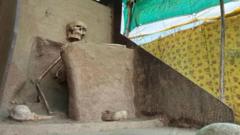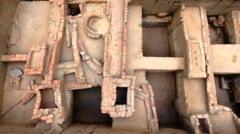A 1,000-year-old human skeleton, excavated six years ago in India, has finally found a proper home at a local museum in Vadnagar, Gujarat. Originally buried in a cross-legged position, the skeleton spent years under a makeshift tarpaulin shelter due to administrative disputes. The recent relocation marks a significant moment for archaeological preservation.
On Thursday, the skeleton was carefully transported from its temporary shelter to the museum, where authorities plan to display it to the public once final approvals are secured. According to Mahendra Surela, curator at the Archaeological Experiential Museum, the skeleton was moved with great caution and monitored by experts throughout the process. Currently, it is positioned next to the reception area, protected by barriers to ensure its safety while awaiting further assessment.
Discoverer Abhijit Ambekar expressed satisfaction with the skeleton finally receiving the recognition it merits, highlighting its rarity; similar remains have only been found at three other sites in India. The prolonged wait for a secure display site left the skeleton vulnerable to environmental factors and lack of protection, sparking concern among experts during its time in limbo.
Scholars speculate that the remains date back to the Solanki period, which stretches from 940 to 1300 CE, during the rule of the Solanki or Chaulukya dynasty. The soil surrounding the skeleton has unusual qualities that contributed to its preservation over the centuries. Ambekar noted that the findings could provide insight into "samadhi burials," an ancient Hindu practice where esteemed individuals were interred rather than cremated.





















